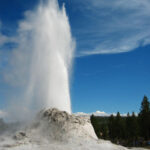Mexican Wolves once ran wild in the hills of the Mexican and Arizona,j and the U.S. government helped farmers and ranchers eredicate the predator at the turn of the century. Now the government wants to expand speciecie – and that has some people worried and angry.
Mexican Gray wolves were declared an endangered species in 1976; today there are only 175 of the animals left- all in captivity. To boost the population the government plans to release the wolves in Arizona.
A wolve repopulation program already is under way in Yellowstone National Park, Wyoming – More wolves are returning to the wild west.
At the insistence of powerful cattle-grower associations, wolves wondering outside a designated zone in eastern Arizona and western New Mexico have been removed either by capture or killing. In addition, the policy for wolves that prey on livestock is three strikes you’re dead. This led to the killing this spring of 12 wolves, including 6 pups. Small wonder, then, that the Mexican wolf-reintroduction project is having trouble meeting its projection of 102 animals by the end of the year. There were never more than 60 and are probably fewer than 40 adults today.
Attempting to stern the loss, the Fish and Wildlife Service has agreed to a slew of program changes, including allowing wolves to roam outside the recovery area boundaries. But it explicity refuses to make ranchers responsible for disposing of livestock caracasses, which can habituate wolves to feeding – and preying- on cattle. In the Northern Rockies, where reintroduction of the gray wolf has been enormously successful, ranchers are responsible for removing “attractants” from their properties – and ineligible for predator – control services if they do not.
COMMUNICATION OF THE WOLF
The wolf’s vocabulary consists of five basic calls: howls, barks, growls, whimpers and squeaks. Wolves use the calls individually or in combination to talk to other wolves. A howl can be heard for great distances and be interpreted in different ways by the wolf it’s being delivered to. A lone wolf may howl to tell pack members of its location or to signal that a wolf is defending its territory. Or a howl can be used to regroup a pack that becomes separated during a hunt.
There is also a group how, which is sometimes accompanied by nuzzling and tail wagging among the howlers. They are not howling at the moon but displaying pack cammaraderie. These versatile “singers” can alter their voices to such a degree that to the human ear, three or four howling wolves may sound like 20 harmonizers.
A bark is a kind of long-distance call too, often used to warn pack members of danger or when a wolf is alarmed by an intruder.
A growl, usually to scare off an unwelcome visitor or to discipline rambunctious pups. Hair raising on the back of a wolf’s neck often accompaies a growl.
All of this is part of the communication system of the wolves’ complex society.






